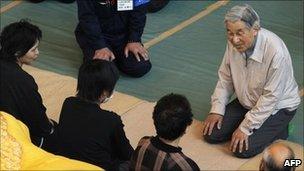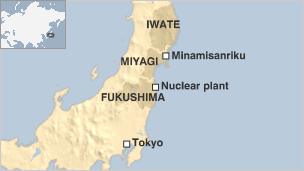Japan emperor visits port devastated by tsunami
- Published

Emperor Akihito talked to residents in a gymnasium in a quake-devastated town
Japan's imperial couple have travelled to tsunami-hit areas on the north-east coast to visit residents in shelters.
Emperor Akihito and Empress Michiko visited the devastated port of Minamisanriku, where more than 1,350 people are missing or dead.
The couple have been to quake-affected areas further to the south but this is their first visit to the region worst hit in the 11 March disaster.
Work to cool reactors at the damaged Fukushima nuclear plant is continuing.
The earthquake and subsequent tsunami knocked out cooling systems at the six-reactor Fukushima Daiichi nuclear plant.
A 20-km (12 mile) no-go zone is being enforced around the plant as workers pump water into reactor buildings to prevent fuel rods overheating.
'Thankful'
The 9.0-magnitude earthquake is now known to have killed 14,517 people, with another 11,432 still missing, according to the latest figures from the National Police Agency.
In Minamisanriku, a port town of about 20,000 people, more than 3,800 homes were destroyed by the tsunami, forcing many residents into evacuation shelters.

The imperial couple visited a gymnasium in the town where 200 people are living.
"I'm thankful he has come so far. It makes me so happy," 73-year-old Mitsuko Oikawa, whose house was washed away, told the Associated Press news agency.
Officials say the couple will travel further north to Iwate prefecture next week and then visit Fukushima residents forced from their homes by the nuclear crisis in March.
On Wednesday Junichi Matsumoto, general manager of plant operator Tepco (Tokyo Electric Power Company), said: "We are injecting more water into the No 1 reactor. We began doing so at 1002 today, and we are increasing the injection of water."
Increasing the water flow will allow engineers to see if there are any leaks, before moving to fully flood the containment vessel - a steel and concrete shell that houses the reactor - in a procedure called water entombment.
The containment vessel in reactor No 2 is thought to be damaged. Highly radioactive water thought to have leaked from there is being transferred to storage on site, forcing Tepco to pump less contaminated water into the sea.
Tepco said it planned to seal damaged sections in the No 2 reactor with cement so water would not leak out.
The company says it will take up to nine months to stabilise the plant. Eighty-thousand residents have been moved from the area and bans imposed on some local food products.
On Wednesday Japan's sovereign rating outlook was cut to negative by Standard & Poor's in the wake of the disaster.
The ratings agency said reconstruction efforts were likely to further increase Japan's debt levels.